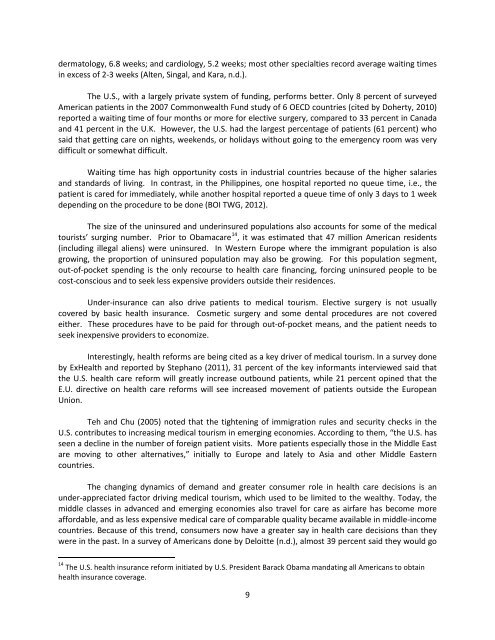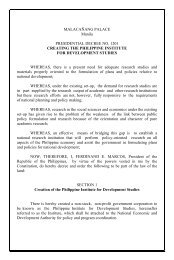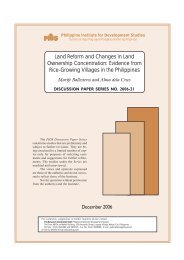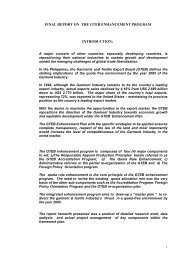Medical Tourism in the Philippines - Philippine Institute for ...
Medical Tourism in the Philippines - Philippine Institute for ...
Medical Tourism in the Philippines - Philippine Institute for ...
Create successful ePaper yourself
Turn your PDF publications into a flip-book with our unique Google optimized e-Paper software.
dermatology, 6.8 weeks; and cardiology, 5.2 weeks; most o<strong>the</strong>r specialties record average wait<strong>in</strong>g times<strong>in</strong> excess of 2-3 weeks (Alten, S<strong>in</strong>gal, and Kara, n.d.).The U.S., with a largely private system of fund<strong>in</strong>g, per<strong>for</strong>ms better. Only 8 percent of surveyedAmerican patients <strong>in</strong> <strong>the</strong> 2007 Commonwealth Fund study of 6 OECD countries (cited by Doherty, 2010)reported a wait<strong>in</strong>g time of four months or more <strong>for</strong> elective surgery, compared to 33 percent <strong>in</strong> Canadaand 41 percent <strong>in</strong> <strong>the</strong> U.K. However, <strong>the</strong> U.S. had <strong>the</strong> largest percentage of patients (61 percent) whosaid that gett<strong>in</strong>g care on nights, weekends, or holidays without go<strong>in</strong>g to <strong>the</strong> emergency room was verydifficult or somewhat difficult.Wait<strong>in</strong>g time has high opportunity costs <strong>in</strong> <strong>in</strong>dustrial countries because of <strong>the</strong> higher salariesand standards of liv<strong>in</strong>g. In contrast, <strong>in</strong> <strong>the</strong> Philipp<strong>in</strong>es, one hospital reported no queue time, i.e., <strong>the</strong>patient is cared <strong>for</strong> immediately, while ano<strong>the</strong>r hospital reported a queue time of only 3 days to 1 weekdepend<strong>in</strong>g on <strong>the</strong> procedure to be done (BOI TWG, 2012).The size of <strong>the</strong> un<strong>in</strong>sured and under<strong>in</strong>sured populations also accounts <strong>for</strong> some of <strong>the</strong> medicaltourists’ surg<strong>in</strong>g number. Prior to Obamacare 14 , it was estimated that 47 million American residents(<strong>in</strong>clud<strong>in</strong>g illegal aliens) were un<strong>in</strong>sured. In Western Europe where <strong>the</strong> immigrant population is alsogrow<strong>in</strong>g, <strong>the</strong> proportion of un<strong>in</strong>sured population may also be grow<strong>in</strong>g. For this population segment,out-of-pocket spend<strong>in</strong>g is <strong>the</strong> only recourse to health care f<strong>in</strong>anc<strong>in</strong>g, <strong>for</strong>c<strong>in</strong>g un<strong>in</strong>sured people to becost-conscious and to seek less expensive providers outside <strong>the</strong>ir residences.Under-<strong>in</strong>surance can also drive patients to medical tourism. Elective surgery is not usuallycovered by basic health <strong>in</strong>surance. Cosmetic surgery and some dental procedures are not coveredei<strong>the</strong>r. These procedures have to be paid <strong>for</strong> through out-of-pocket means, and <strong>the</strong> patient needs toseek <strong>in</strong>expensive providers to economize.Interest<strong>in</strong>gly, health re<strong>for</strong>ms are be<strong>in</strong>g cited as a key driver of medical tourism. In a survey doneby ExHealth and reported by Stephano (2011), 31 percent of <strong>the</strong> key <strong>in</strong><strong>for</strong>mants <strong>in</strong>terviewed said that<strong>the</strong> U.S. health care re<strong>for</strong>m will greatly <strong>in</strong>crease outbound patients, while 21 percent op<strong>in</strong>ed that <strong>the</strong>E.U. directive on health care re<strong>for</strong>ms will see <strong>in</strong>creased movement of patients outside <strong>the</strong> EuropeanUnion.Teh and Chu (2005) noted that <strong>the</strong> tighten<strong>in</strong>g of immigration rules and security checks <strong>in</strong> <strong>the</strong>U.S. contributes to <strong>in</strong>creas<strong>in</strong>g medical tourism <strong>in</strong> emerg<strong>in</strong>g economies. Accord<strong>in</strong>g to <strong>the</strong>m, “<strong>the</strong> U.S. hasseen a decl<strong>in</strong>e <strong>in</strong> <strong>the</strong> number of <strong>for</strong>eign patient visits. More patients especially those <strong>in</strong> <strong>the</strong> Middle Eastare mov<strong>in</strong>g to o<strong>the</strong>r alternatives,” <strong>in</strong>itially to Europe and lately to Asia and o<strong>the</strong>r Middle Easterncountries.The chang<strong>in</strong>g dynamics of demand and greater consumer role <strong>in</strong> health care decisions is anunder-appreciated factor driv<strong>in</strong>g medical tourism, which used to be limited to <strong>the</strong> wealthy. Today, <strong>the</strong>middle classes <strong>in</strong> advanced and emerg<strong>in</strong>g economies also travel <strong>for</strong> care as airfare has become moreaf<strong>for</strong>dable, and as less expensive medical care of comparable quality became available <strong>in</strong> middle-<strong>in</strong>comecountries. Because of this trend, consumers now have a greater say <strong>in</strong> health care decisions than <strong>the</strong>ywere <strong>in</strong> <strong>the</strong> past. In a survey of Americans done by Deloitte (n.d.), almost 39 percent said <strong>the</strong>y would go14 The U.S. health <strong>in</strong>surance re<strong>for</strong>m <strong>in</strong>itiated by U.S. President Barack Obama mandat<strong>in</strong>g all Americans to obta<strong>in</strong>health <strong>in</strong>surance coverage.9









